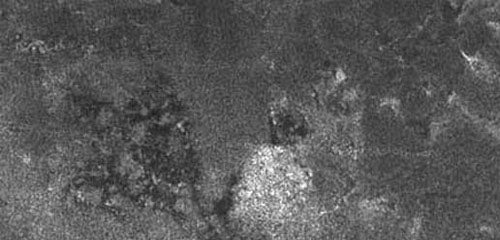Cruising less than 720 miles (1,200 kilometers) above Titan, Cassini’s sophisticated radar gave planetary scientists their first up-close glimpse of Titan’s surface. Dynamic processes such as hydrocarbon rain and possibly low-temperature volcanism are creating a geologically young surface.
Researchers are just now releasing detailed results from Cassini’s close encounter with Titan October 26, 2004. The new radar findings appear in the May 13, 2005, issue of Science. Cassini was able to map just 1 percent of Titan’s surface in a long, narrow strip. The tantalizing images reveal a young, complex surface with very few impact craters, some signs of ice and frozen hydrocarbons, and what may be a 110-mile-wide (180 km) ice-volcano dome.
The scientists are struck by similarities between Titan — the second-largest moon in the solar system, and the only one with a substantial atmosphere — and Earth. “Despite the large difference in temperatures between Titan and Earth, there are many features that are reminiscent of those on Earth — channels, apparent flows, volcanic-looking constructs,” Stephen Wall, deputy radar science team leader at the Jet Propulsion Laboratory (JPL), tells Astronomy. “That was surprising.”
Volcano or crater?
Probably the most intriguing feature revealed by Cassini’s radar is a large, roughly circular dome tentatively named Ganesa Macula. Although JPL’s radar team can’t rule out the possibility that Ganesa Macula is an uplift dome or a weathered impact crater, they think it’s more likely to be volcanic, complete with a central volcanic caldera and sinuous channels that look like they carried bright, radar-reflecting materials for up to 54 miles (90 km).
If Ganesa Macula is a volcano, it almost certainly operates at an extremely low temperature — a process called cryovolcanism — spewing water or a water-liquid ammonia mix as magma. Wall would love to know the details. “That’s the $64,000 question, with adjustments for inflation, of course,” he says. “Some combination of ammonia and water may be flowing. Solids might be ejected too — methane and water ice are examples.”
A variety of landscapes
The researchers are equally intrigued by irregularly shaped radar-dark areas with distinct edges that resemble interconnected lakes. One of these features has been nicknamed “SiSi the Cat” after an engineer’s daughter named SiSi noticed its cat-like shape. Some of these dark areas may be lakes or mudflats, with ammonia-water or liquid methane substituting for water, and sludge-like hydrocarbons standing in for sand or mud. (Titan’s surface is a frigid –290° Fahrenheit [–179° Celsius].)
Cassini also saw areas that reflect radar like a mirror — corroborating the “specular echoes” detected in 2003 by the Arecibo Radio Observatory in Puerto Rico. This indicates areas that are extremely smooth, again possibly mudflats or lakes. “But that’s still a little more of a leap than we would like to make,” says Wall.
Jonathan Lunine of the University of Arizona’s Lunar and Planetary Laboratory is surprised by Titan’s complexity. “The diversity of surface features over just 1 percent of the surface was unexpected.” He’s sure Cassini will reveal “even more variety and a few real zingers” during its next 38 close flybys.










